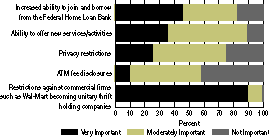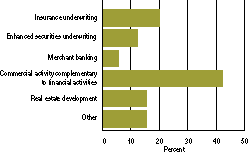To get a feel for what bankers in the Ninth District think about the Gramm-Leach-Bliley Act, the Minneapolis Fed sent a survey to its 942 Ninth District banks and received almost 400 replies. Survey results show a wide range of interest and concern for different parts of the new law and its impact on banking.
For example, little attention was paid by the media to the closing of the unitary thrift loophole (the so-called Wal-Mart rule). But it was easily the strongest blip on the radar screen of bankers in the largely rural Ninth Federal Reserve District. Nine of 10 bankers said the measure was very important—twice the concern level given the next closest item.
With the walls of Glass-Steagall torn down, bank respondents also identified a wide variety of new activities they are interested in pursuing. More than four of 10 said they were interested in new commercial activity that was complementary to existing bank activities. No other opportunity opened by the new law received even half as many votes.
Banking Voices
Below is a sample of comments from bankers who responded to a recent banking survey by the Minneapolis Fed.
The financial modernization act is very important for a community
bank like ours. It will allow us to accelerate our strategic plan
to be a "financial service center," not just a bank by previous
definitions. A community bank that does not change with the market
will not be around in five years.
I am concerned that financial services legislation passed recently
on top of the interstate branching law passed a short time ago
are increasing the systemic risk to the industry. We are seeing
bankers getting involved in activities they may not be ready for,
such as branching (and) new product lines with additional risk,
that will lead to problems. I suspect the (new law) will result in mergers of banks, insurance
and investment companies. However the industry cultures and product
competencies will take some time to unfold profitably for many
of the mergers. Customer service and relationship management will
be a common denominator for success. The effect of this legislation on smaller banks is likely to
be indirect by virtue of the consolidation it promotes and the
broadening of player eligibility in the financial services arena.
The former may not be bad for the economy taken as a whole, but
will be harmful for the parity so far as it concentrates economic
power. The latter may or may not increase competition-it will
provide more players horizontally but fewer vertically-but it
will likely make matters more difficult for those financial institutions
that don't assume new powers or form strategic alliances. As with
any regulation, change will be slow in all rural areas. Our population
numbers will not warrant fast changes, so this survey is just
a snapshot in time. The financial services modernization law will
help escalate the demise of rural communities and rural banks.
This is the exact plan big banks, brokerage firms and U.S. government
had in mind when passing this legislation. The ultimate goal is
to get rid of anything rural or small-belt farms, business, manufacturing
or banks. The enclosed quotation from Walter Wriston says volumes
about banking and its competitive position. "All I can tell you
is that the banking business used to have about 70 percent of
the financial assets of the world. Now we have about 30 percent.
Do you know any industry that went from 70 down to 30 percent
of market share and survived?" See the results of the survey, fedgazette, April 2000. How important to your organization are the following changes
made by the Financial Services Modernization Law?

Which of the following new services or activities would you
take advantage of, if allowed, under the recently passed law?

How will this law affect the level of competition in the
delivery of financial services in your market?





